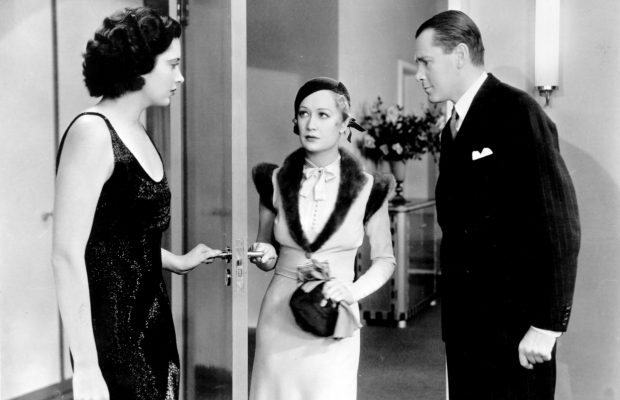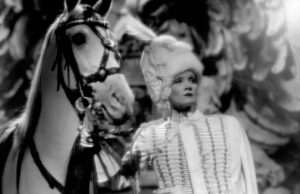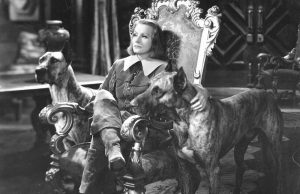Trouble in Paradise (1932)

Toronto Film Society presented Trouble in Paradise (1932) on Monday, July 11, 2016 in a double bill with The Ex-Mrs. Bradford as part of the Season 69 Summer Series, Programme 1.
Production Company: Paramount Pictures. Producer and Director: Ernst Lubitsch. Screenplay: Samson Raphaelson. Adaptation: Grover Jones, from the play “The Honest Finder” by Laszlo Aladar. Cinematographer: Victor Milner. Sets: Hans Dreier. Music: W. Franke Harling. Gowns: Travis Baton. Songs: Harling and Leo Robin: Trouble in Paradise, Colet and Company.
Cast: Miriam Hopkins (Lily Vautier), Kay Francis (Mariette Colet), Herbert Marshall (Gaston Monescu), Charles Ruggles (The Major), Edward Everett Horton (Francois Filiba), C. Aubrey Smith (Adolph Giron), Robert Greig (Jacques, Mariette’s Butler), George Humbert (Waiter), Rolfe Sedan (Purse Salesman), Luis Alberni (Annoyed Opera Fan), Leonid Kinsky (Radical), Hooper Atchley (Insurance Agent), Nella Walker (Madame Bouchet), Perry Ivins (Radio Commentator), Tyler Brooke (Singer), Larry Steers (Guest).
If you have never had the opportunity to see Trouble in Paradise, then you are in for a treat. The first time I saw this film was when I was visiting film historian William K. Everson in New York and he invited me to watch it along with his students. Since then, I have enjoyed it a number of times. It’s considered one of the unequivocal films of pre-Code and Kay Francis’s most famous. Unfortunately, as he always has something of interest to say, the notes that Mr. Everson would have written about the film are not available for reproduction. Take note that a double would have had to have been used for Herbert Marshall in the scenes where he is bounding up and down the staircase. On 9 April 1917, fighting in France during the First World War, Marshall was shot in the right knee by a sniper. After a succession of operations, doctors were forced to amputate his leg near the hip. But this didn’t stop Marshall from a successful acting career.
When I was at Cinevent in Columbus, Ohio, I briefly met author Scott Eyman and purchased his biography on Lubitsch. I want to share with you some interesting pieces of information from his book:
Samson Raphaelson wrote the screenplay which was based on the play “The Honest Finder” by Laszlo Aladar. As you will read in the notes, the central character played by Herbert Marshall was based on the famous Hungarian swindler and thief Georges Manolescu, whose 1907 memoir resulted in at least two silent films, one in 1929, starring famous Russian actor Ivan Mosjoukine.
But Lubitsch most probably knew of Manolescu, and he and Raphaelson invariably found they had an intriguing central situation, and romantic characters, within the play. Psychologically, it made more sense to Lubitsch to fix what was broken than to build from the ground up. In the fifteen years remaining to him, Lubitsch would produce only one entirely original script, proving that he was a gifted creator as well as an interpreter. Although uncredited as the writer, To Be Or Not To Be was considered one of his greatest films.
Notice the opening shot: What Lubitsch and Raphaelson finally came up with was the famous opening where the singer of a glorious operatic air turns out to be a trash collector. Even in glorious, romantic Venice, someone has to pick up the garbage but, this being Venice—and Lubitsch—they must do it with panache. This sardonic undercutting of the ordinary is perhaps the quintessential “Lubitsch touch,” but the director was careful not to overdo a good thing.
After the expenses of his last several pictures, Lubitsch cut back with Trouble in Paradise costing only $519,706. It was not until early October, nearly a month after the film finished production, that the film was finally titled Trouble in Paradise, which won out over temporary titles like “The Golden Window”, “Thieves and Lovers”, and “A Very Private Scandal”. As was usually the case, Lubitsch came up with the title. The only title Raphaelson ever contributed to their collaborations was The Smiling Lieutenant.
More heavily scored than most 1932 films, Lubitsch directs Trouble in Paradise as if it were an art deco musical, with the dialogue in place of lyrics and the characters as the elegant score. Miriam Hopkins runs at her usual frantic pace, but Herbert Marshall and the languid, knowing Kay Francis become the film’s shimmering, tranquil erotic center.
Lubitsch never tries to make the characters conventionally warm or likable. At one point, Lily (Hopkins) tells Madame Colet (Francis) that her mother is dead. That’s the trouble with mothers,” Colet responds. “First you get to like them. Then they die.” Gaston orders 11 deep red roses for Mariette as a parting gift, but has them put on her tab. The characters’ heartlessness is part of their charm. They may lie, but never to each other; unlike the character played by C. Aubrey Smith, they’re not hypocrites.
At the same time, Lubitsch creates a world that, underneath the glowing surfaces of Hans Dreier’s furniture and sets, is recognizably real. People steal while pretending to be honest, they fret more over a lost handbag than over the starving people they pass on the way to work. These ironies are never stated directly, but they’re there nonetheless.
Filling out the Lubitsch frame were the miraculous character actors who remained a constant, even when the stars varied; the gracious, serene, befuddled Charlie Ruggles and the nervous ditherer Edward Everett Horton. Horton discovered that Lubitsch always had the actor in mind when he was writing the part. Horton particularly liked the fact that Ernst insisted that the actors rehearse for an entire week on the sets before beginning photography. “No matter what you thought or what you wanted to do, Mr. Lubitsch had gone over it in his mind and had come to a conclusion,” remembered Horton. “Just as soon as you could put yourself en rapport with him, you were very happy. “He knew actors very well,” concluded Horton, “and he wanted something from them that even they didn’t know they had. He was a genius, you see.”
Both Travis Banton, costume designer, and Hans Dreier, set designer, worked well in tandem and that shows in this film. Since Banton’s costume designing stopped at hats, they were designed by Lily Daché.
Caren Feldman
“Champagne reflected in moonlight” aptly describes Paramount’s Trouble in Paradise. Director Ernst Lubitsch’s satirical treatment of jewel thievery translates to many as a cinematic love letter to Kay Francis and is considered her best film. She was Mariette Colet, a delightfully feminine captain of industry, smart and knowing. She seems bemused when she finds herself in the midst of a tantalizing erotic triangle. And how does this happen? She loses her enormously expensive handbag at the opera and discovers, with an air of delight, that its “honest finder,” Gaston Monescu (Herbert Marshall) is not only très charmant, but compellingly attractive as he murmurs his way into her employ and boudoir. Lubitsch disregarded Aladar Laszlo’s play, from which the film was loosely adapted, and concentrated on the intriguing situations and characters. The play, A Becsuletes Magtalalo (The Honest Finder), opened in Budapest in December 1931. The central character, Monescu, was based on the famous Hungarian swindler Georges Manolescue, whose Memoirs, published in 1907, had inspired several films.
The famous Lubitsch touch is felt everywhere, from the opening shot of an operatic trash collector maneuvering through Venice in his gondola, to Monescu’s fond farewell to Mariette. By the finis one sees Monescu as a professional, whose skills and manipulations are simply poetic justice. The elaborate lifestyle of Mariette Colet and her well-heeled crowd is begging to be robbed, preferably by an equally elegant, clever master. What sets Mariette apart is that she seems to realize this necessity, hence her gracious attitude upon Monescu’s departure. At his leave, she nods dreamily to his query: “Do you know what you’re missing?” The audience understands exactly, the content of her reverie, before Monescu lovingly, playfully, reaches for the pearl necklace tucked away in his pocket. “No,” he tells her, holding up his farewell heist. “That’s what you’re missing…your gift to her.” Without skipping a beat, Mariette graciously complies with his confession, and the intended gift for the other woman in his life. She replies, bittersweetly, “With compliments of Colet and Company.”
The third party of Lubitsch’s triangle is the zesty, if high-strung, Miriam Hopkins. She is Monescu’s comrade in crookedness, Lily. It’s difficult to believe that Monescu prefers her to the shimmering Kay Francis. The answer to this incongruity is best put in the words of Lubitsch author Scott Eyman. “Love and larceny not only coexist, they positively bask in each other’s company.” Monescu and Lily are addicted to the thrill of thievery and the competitive edge that compels them.
After rejecting the casting choices Paramount gave Lubitsch for the picture, he had no trouble coming up with his own. He had already written parts for specific actors: Edward Everett Horton and Charlie Ruggles. Lubitsch had considered working with Kay earlier that year in One Hour With You. When he realized the male lead, Maurice Chevalier, had his hungry eye on Kay, Lubitsch avoided the inevitable complications. He cast Jeanette MacDonald instead. Lubitsch was well aware of Herbert Marshall’s reputation with women. “While very much married, Marshall managed affairs with both Kay Francis and Miriam Hopkins,” says Eyman, “as well as a serious relationship with Gloria Swanson, all within the pace of a few years.” If Marshall and Kay did have an affair, it was not mentioned in her diary.
As for Hopkins, Lubitsch was also attracted to her. He liked her. “He may have been the only person in show business who did,” Eyman clarified. “Hopkins managed to simultaneously entice him and keep him at arm’s length. Photographer John Engstead referred to her as ‘that old…bitch. You should have seen how cute she was with Ernst Lubitsch. And Lubitsch never saw through her.” As a reward for taunting him, Lubitsch kept casting Hopkins in his films, which propelled her into the realm of top-ranking star. Hopkins was a handful. According to Eyman: “There were the usual…complications, courtesy of the frantic Miriam Hopkins. In one scene, Hopkins ruthlessly upstaged Kay Francis by slowly turning the chair in which she was sitting until her profile had magically become her entire face.” After Kay complained to Lubitsch, the problem was resolved simply by nailing the chair to the floor. Onscreen, Francis seems amused by the perpetually agitated Hopkins. The contrast between the two provides a silkier edge to Marshall’s scenes with Francis. Francis and Hopkins weren’t necessarily feuding throughout the making of the film. They were frequently on one another’s dinner guest list during the 1930s and a few years later it was Kay who accompanied Miriam and Miriam’s adopted son to Reno when Hopkins divorced director Anatole Litvak.
Trouble in Paradise establishes sexual innuendo in the opening credits with its title superimposed above an elegant double bed. We are introduced to the gentleman-thief Monescu (Marshall) in his posh hotel room ordering a “most marvelous supper” that he and his guest Lily (Hopkins) “may not eat.” We then relocate to the environs of Colet and Company, a French parfumerie. Their motto is: “Remember, it doesn’t matter what you say, it doesn’t matter how you look, it’s how you smell.” The head, the beautiful and frivolous head of the company, is Mariette Colet (Francis). As to the board’s decision on salary cuts, she simply announces “Leave things where they are!” Business bores her, and besides, she has a luncheon engagement. The two plots are joined together at the opera where Monescu steals Mariette’s bejeweled purse. The opera score itself spoofs love relationships. Performed in English—we hear an ACT I aria in which the soprano warbles, “I love you. I love you. I love you.” Pages of the conductor’s score fly by to ACT III and we hear the inevitable “I hate you!”
Responding to an advertisement for the return of the lost evening bag and a reward of 20,000 francs, Monescu, guised as Monsieur La Valle, shows up at Mariette’s home. With flirtatious charm he critiques her love letters, offers advice on the correct shades of lipstick and powder for her complexion, and chastises her for not having more than 100,000 francs in her safe. “If I were your father, which fortunately I am not,” he advises, “and you made any attempt to handle your own business affairs, I would give you a good spanking. In a business way, of course.” Kay responds with, “What would you do if you were my secretary?” “The same thing,” he assures her. She leans back, smiling and very interested. “You’re hired!” she declares. As Mariette and Gaston’s affair ripens, Lubitsch teases the viewers’ imagination using a series of visuals: an Art Deco clock defines the length of the romantic interlude; a telephone is left unanswered; and nearby, a champagne bottle’s cork has been “popped.” Parting glances contain revelations of unspoken dialogue.
Throughout the film Lubitsch establishes the tentative nature of romantic relationships. At the film’s fin, Mariette discovers Gaston’s secret: he’s an imposter. She is saddened, but philosophical. What could have been, simply wasn’t meant to be. Their parting is a gracious one. He escapes into the unknown with his “sweet little pickpocket,” Lily.
From the get-go, reviews for the film were glowing. Columnist Jimmy Starr pointed out, “Miriam Hopkins may receive first billing on the credit card, but Kay Francis, borrowed from Warner Brothers…steals the honors.” Previewed for the Los Angels Record, Llewellyn Miller wrote, “Trouble in Paradise is as fragile as an orchid and just as rare. It is pictures like this which make people like me decide that life spent in theaters is worth while after all.” Variety missed the gondola all together. “Swell title, poor pictures,” said the reviewer. “Will have box office trouble.” On the east coast, The New York Times, concurred with the L.A. critics about “the alert-minded Ernst Lubitsch’s…shimmering, engaging piece of work…the only person in Hollywood who could have turned out such an effective entertainment from such a feathery story.” Happily, Trouble in Paradise provided Kay the opportunity to prove herself as a captivating comedienne. Her sleek energy and wry wit leave the viewer intoxicated, satisfied.
Cheerfully amoral, when Trouble in Paradise was up for reissue in 1935, it was rejected by the Production Code. The Code forbade a story focused on sexual swapping and unpunished crime. Lubitsch had a world view that embraced, wholeheartedly, the sexual being. When it was reported that his brother, Richard, had died of a heart attack while visiting a brothel, Lubitsch wasn’t fazed in the least. “Kings and princes die in whorehouses,” he told his niece. “Why should we be ashamed?” The rest of his family remained embarrassed and appalled. The scourge of the Production Code kept Trouble in Paradise out of circulation for decades. It was only shown at private film festivals, which kept its reputation alive as one of the best film comedies. Lubitsch was in attendance at a 1947 screening presented by the Great Films Society at Rexford School in Beverly Hills. Buoyed by an appreciative audience viewing Trouble in Paradise, Lubitsch knew it would always be a consensus classic. He died a few months later. Film critic Leslie Halliwell wrote with rapturous delight about the film. “It has been in my mind and my heart since the Sunday morning in 1949 when Cambridge’s Film Society, a thousand strong, rose to it as one man and gave it a deafening ovation; later I booked it at the Rex as a double bill with French without Tears…we had to turn hundreds away, after which it became as firm a favourite as Genevieve, The Lavender Hill Mob, or anything starring the Marx Brothers.” Lubitsch and his cast captured an elegance and effortless grace that escapes modern filmmakers. The film’s intelligence and polish remain unmatched.
Kay Francis, I Can’t Wait to be Forgotten: Her Life on Film and Stage by Scott O’Brien (2007)
Sadly, many people today don’t know who Kay Francis was, although she herself once said, “I can’t wait to be forgotten.” People think that the most glamorous and fashionable woman of the 1930s was Carole Lombard, or perhaps her more exotic counterpart Marlene Dietrich. Lombard, however, was a talented comedienne and often a good serious actress. Dietrich was an original, a representation of an androgynous ideal for whom glamour and fashion were tools to be used, but for whom they could never provide the complete definition. Both these women wore clothes well, but their careers have substance beyond the label of “clotheshorse.” Kay Francis was only fashion and glamour, a true star of the woman’s film. She forged a top-drawer career out of nothing but tears and tiaras, a clotheshorse who gave significance to the term.
The camera seems to love Kay Francis. She doesn’t look quite like anyone else, and close inspection indicates that she is not a beauty in the usual sense. She is odd looking, really, and she has a slight lisp. But she was born for the bias cut, and she walks through the scuzziest of melodramas as if she were being presented at court. It is often only her modern, almost austere presence that keeps certain weepie movies from going down for the third time. She inhabits the plots as if she were at the Ritz, and she knows how to sacrifice herself and suffer without making you want to kill her. There is a soft loveliness to her voice and body, and a clearly defined line to her shape and head. Her dark hair frames her face, with its generous mouth and broad brow, its luminous eyes. When she’s on-screen and dressed right, she’s the center of attention, and no one, no matter how much more talented, can take it away from her. When she’s cast in a part that uses her ability for sly mockery, for her “isn’t this a hoot, but let’s enjoy it darlings” quality, she is terrific (Trouble in Paradise, 1932). She has true sophistication and an honest languor, and like all great movie stars, she seems to invite the audience into a conspiracy of some sort. In her case, it’s a conspiracy that suggests she knows, and the viewer knows, that what is going on in the plot is sheer nonsense, but…The “but” is a soupçon of credibility, the hint that it’s bad for us but we need it, and we need it because we want to believe in it. Believe in it? Believe in Russian female scientists who pose as whores, and lady doctors who save the lives of dying babies with hairpins snatched from their own heads? Believe in it? “Let’s do it,” says Kay, and we do. It’s her “let’s do it and the hell with it, you know we want to” quality that makes her perfect for the woman’s film, with its contradiction, its ambivalence, and, of course, its frequently lunatic stories that we all secretly love but feel we ought to be ashamed of.
A Woman’s View: How Hollywood Spoke to Women 1930-1960 by Jeanine Basinger (1993)
Toronto Film Society first screened Trouble in Paradise on Monday, January 3, 1977 in a double-bill with The Lost Squadron as part of the Season 29 Monday Evening Film Buff Series, Programme #5. You can read these notes here.
Notes compiled by Caren Feldman
www.carensclassiccinema.wordpress.com















Leave a Reply